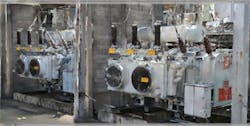Context-aware tech, part 2: Who’s leading the charge?
Early adopters of context-aware technologies largely have been driven by a few specific goals, say Seegrid VP of engineering Sid Wiesner and Cisco’s Small: more-flexible automation, improved regulatory compliance, and/or better worker safety.
Customers’ desire for more-customized products is helping spur adoption of vision-enhanced robots and other context-aware tech on production lines, especially in the automotive space, Wiesner says. Automakers are “moving to larger areas of automation, and they’re looking for more-flexible automation as they have to adapt to changing market requirements and a more-competitive landscape,” he says. “Now they’re changing (their line) more frequently, so they need automation that can be flexible as they change over.”
The pharmaceutical industry’s tight regulatory requirements have made drug companies early adopters of asset sensors and RFID tags, says Small.
“Because the pharmaceutical manufacturing process is tightly regulated by the FDA, there are specific procedures that you put in place that say, ‘This piece of equipment will be calibrated every 12 months or 18 months,’ ” he says. “And one of the challenges for some of our larger customers where they had 3,000 pieces of equipment ... (was) the 18 months would come up and they wouldn’t be able to locate that piece of equipment that required calibration. So they would have to file a discrepancy report with the FDA saying, ‘We did not calibrate this per our procedure because we simply couldn’t find it.’ ”
[pullquote]
Besides aiding in FDA compliance, pharmaceutical companies have found that RFID tags also allow them to be more efficient in preparing smaller, batch runs of a particular product, Small says. “They would spend in some cases five to six hours searching for a set of 20 pieces of equipment that would have to be assembled to make a batch run,” he says. “By having tags on critical pieces of equipment, they could change and eight- to 10-hour search time into an hour or two.”
As sensor technology and robotics become less expensive, adoption and use of context-aware tech will continue to accelerate, Small and Bentley’s DiMatteo and Huie say.
For hospitals and other healthcare providers, Small points out, RTLS (real-time location system) technology is “absolutely mainstream,” as fast location of medical equipment, drugs, personnel, and more can be a matter of life or death. Manufacturers, too, he says, are starting to appreciate the weighty consequences of unnecessary waits and how new tools can help businesses avoid these. “I think we’re seeing the inflection point also occurring in the industrial space,” he says.
DiMatteo shares the sentiment. “I do think there’s going to be a dramatic shift in the next three to five years,” she says. That shift will be driven in part, Huie says, by “constant cost pressures for these enterprises to become more efficient over time.”
Uptake’s Keywell sees competitive demands pushing context awareness – as a tool in industrial companies’ data arsenal – forward as well. The ability “to gather every ounce of relevant information and find early patterns that indicate signs of impending activity” is new, but it will be a vital asset for forward-thinking industrial businesses, he suggests.
“Those companies that are ... looking out the front window rather than the rearview mirror are very in tune with the opportunities that we are opening up through predictive insight,” Keywell says.
Part 1: What does it look like, and what's it worth to my company?
Part 3: What are the hurdles to adoption, and what's next?




